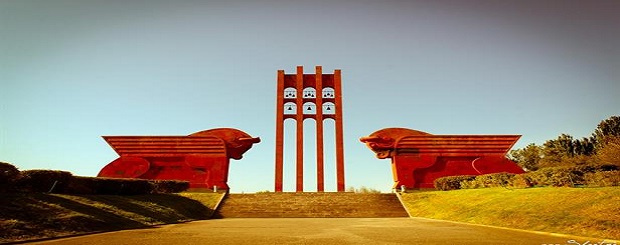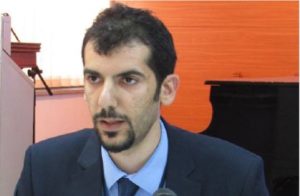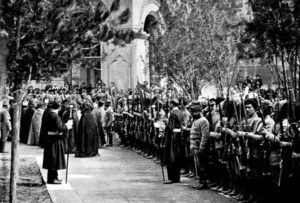
Armenia: The Resurrection of a Nation (By Yeghia Tashjian) – The Resurrection of a Nation
May 28, 2014 – //neweasternpolitics.com//

When God, who is forever free,
Breathed life into my earthly frame,
From that first day, by His free will
When I a living soul became,
A babe upon my mother’s, breast,
Ere power of speech was given to me,
Even then I stretched my feeble arms
Forth to embrace thee, Liberty!
-“Liberty,” by Mikael Nalbandian
In the summer of 2011, my childhood dream came true. I stood in front of the great monument dedicated to the fallen heroes of Armenia. This was where my ancestors declared their independence on the 28th of May 1918, after 6 centuries of oppression. A nation that was once occupied by both the Ottoman Empire and the Russian Empire was reclaimed and once again united. Today, Armenia’s first independence still plays a crucial role in the identity of the Armenian diaspora, because not only did it shape modern-era Armenian nationalism, but it also led to the adoption of the principle of national self-determination.
This is how this small injured nation paved the road toward independence and statehood.
After the Turkish forces “succeeded” in eliminating the Armenians within its empire, it sent its troops to the Caucasus to annihilatethe Armenians living in the Eastern region of their homeland. In 1917, as the Bolshevik Revolution began, Russian forces retreated, leaving the Armenian front defenseless against the mighty Ottoman army.
Consequently, Turkish forces reoccupied the lands of Western Armenia, which had been previously liberated by Russian forces. Impoverished and starved, Armenian refugees fled to the only unconquered land: Eastern Armenia. This was when the famous Armenian revolutionary slogan, “Freedom or death,” was once again revived.

The Turkish army launched an offensive and began to occupy the cities surrounding the capital, Yerevan, which left Armenians feeling despondent. As a result, the Armenian Revolutionary Federation (ARF) took the initiative by forming an Armenian militia, or Fedayi group, that defended Armenian civilians through armed resistance.
Aram Manougian, head of the military council at the time, gave a speech and declared “We are alone; we will not leave Yerevan till the last drop of our blood…fight to the death.” Peasants, priests, intellectuals, women, the elderly and volunteers took up arms against the Turkish army.
In the legendary battle of Sardarabad, the Ottomans were defeated. About 30,000 Turkish soldiers were killed; the Turks were flung out. Afterwards, the defeated Turkish commander, Vahib Pasha, described Armenian soldiers as “the best fighters in the world.”
On May 28, 1918, the National Council of Armenia declared the birth of the Democratic Republic of Armenia.The republic adopted a tricolor flag (red/blue/orange); the red stripe symbolized blood, the blue stripe the sky and the orange stripe represented the soil. Subsequently, national elections were held based on universal suffrage and a government was formed. The Armenians had been dreaming of independence for centuries, and their dream had finally come true.
But, why do Armenians still celebrate Armenia’s first independence…?
The May 28 victory and the short-lived independence of the First Republic of Armenia inspired modern Armenian nationalism, similarly to how the Assyrians Kha b-Nisan and Kurdish Nowruz celebrations influenced modern Assyrian and Kurdish nationalism. Armenian political thinking shifted from the struggle for national liberation to building an Armenian statehood.
In 1919, at the 9th World Congress, the ARF revealed its objective to create a “Free, Independent and United Armenia,” which included the Turkish occupied Armenian territories (Western Armenia). However, on November 29, 1920, the power in Armenia was transferred to the Bolsheviks, and the country became a Soviet Republic.
After the Sovietization of Armenia, the majority of Lebanese-Armenians didn’t recognize the Soviet Armenian Republic, and during celebrations or cultural events raised the Armenian tricolor flag instead of the Soviet Armenian flag. Thus, the Armenian tricolor flag and the May 28 celebrations became a symbol of struggle not only against Turkey, but also against the Soviet Republic. Today in Lebanon, Armenian cultural and political institutions raise the Armenian flag along with the Lebanese flag, not as a symbol of divided loyalty, but to display the identity of the institution.
For many reasons, Lebanese-Armenians dedicate a full week for the celebrations of the first independence. Many argue that if the Armenians hadn’t defeated the Turks and gained independence, Armenia would have been wiped off the map. Thus, they would have become a “people without a land.”
Lebanese-Armenians and the Armenian diaspora also argue that the current third Republic of Armenia is entitled to the territorial rights of the first Republic of Armenia as stated in the Treaty of Serves. Lastly, celebrating the first independence helps Lebanese-Armenians preserve their ethno-political identity, and renews their hopes and dreams for a better future for Armenia.
The perseverance of Armenians revealed that small nations can control their destinies without the help of foreign powers. A nation united is much stronger than one that is divided.Therefore, I believe that small nations should only trust in their own power. When it comes to the struggle for national liberation, a nation that is united and determined can defeat any hostile force.
The article was originally published in NOWLebanon
Yeghia Tashjian has graduated from Haigazian University in political science. He is a Lebanese-Armenian political activist, researcher and blogger. He has founded the New Eastern Politics forum/blog in 2010. Currently, he is the regional officer of Women in War gender-based think tank, and research assistant at Armenian Diaspora Research Center at Haigazian University. He is also contributor to many local and regional newspapers and blogs.
neweasternpolitics.com/armenia-the-resurrection-of-a-nation-by-yeghia-tashjian/
